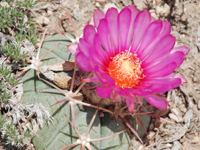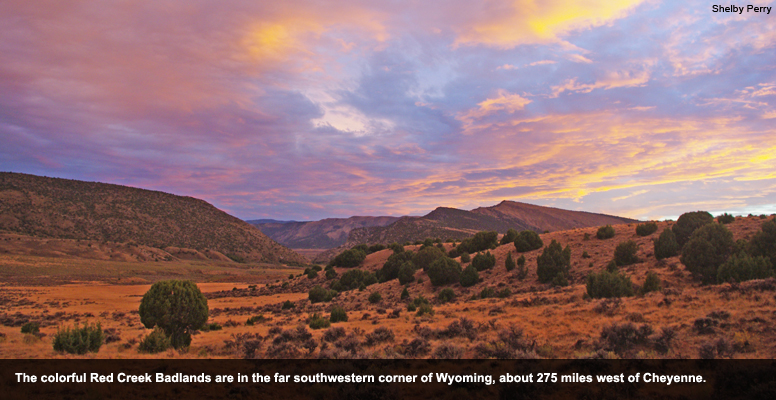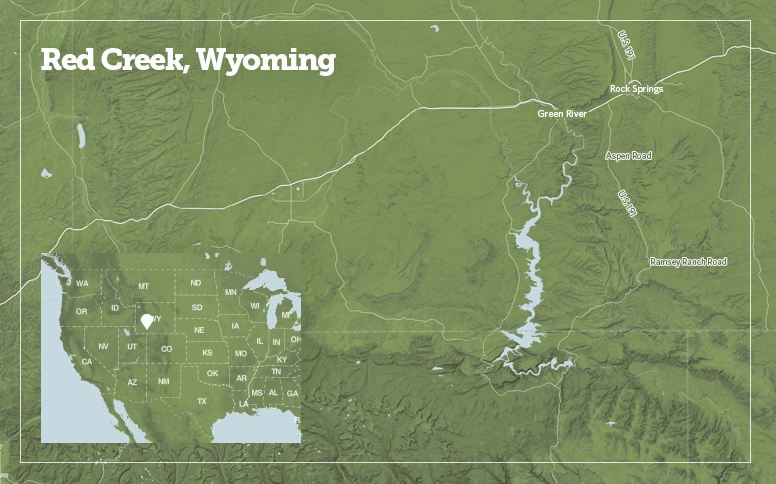Red Creek Badlands: Secluded Wyoming Splendor
The Pew Charitable Trusts is working with local organizations throughout the West and in Washington to ensure that planners at the Bureau of Land Management, or BLM, recognize the scientific, economic, and cultural imperatives to keep our West wild.
Profile
 In the far southwestern corner of Wyoming, about 275 miles west of Cheyenne, badlands of colorful shale and sandstone crumble into the grassy Red Creek Basin. To the south, the Tepee Mountains rise 2,400 feet above the valley floor, providing panoramic views back across Red Creek.
In the far southwestern corner of Wyoming, about 275 miles west of Cheyenne, badlands of colorful shale and sandstone crumble into the grassy Red Creek Basin. To the south, the Tepee Mountains rise 2,400 feet above the valley floor, providing panoramic views back across Red Creek.
Remote and seemingly barren, the Red Creek Badlands teem with wildlife. Elk and pronghorn live here year-round, and mule deer find crucial winter range in this secluded corner of the Cowboy State. Red-tailed hawks, golden eagles, and prairie falcons soar above; greater sage-grouse strut across the grassy valley; and the rare Colorado River cutthroat trout still swims in Red Creek.
The central basin, cut by valleys and gullies that flow into Red Creek, is a sagebrush steppe with stands of juniper and cedar on the hillsides. Aspen grow on the ridges and valleys of the Tepee Mountains. Piñion pines, rare this far north, are found throughout the area.

The Red Creek Badlands are part of a vast treasury of public land in Wyoming. They are owned by all Americans and overseen by the Bureau of Land Management. A portion of the area is protected, for now, as part of an 8,660-acre wilderness study area. But the vast majority of these lands are unprotected spaces threatened by oil development and off-road-vehicle use that greatly accelerates erosion and degrades their beauty.
BLM is revising its Rock Springs management plan for 3.5 million acres of public land in a large area including the Red Creek Badlands. The Pew Charitable Trusts, the Biodiversity Conservation Alliance, and other local partners are encouraging the agency to conserve a greater portion of this area to more effectively preserve its ecological richness and responsibly balance conservation with energy development. The alliance has collected valuable information about wilderness characteristics that should be used as a guide for the agency's effort.
“The interest of the public clearly lies on the side of preserving this magnificent landscape to be enjoyed by countless future generations of Americans,” says Shelby Perry, who surveyed the area for the alliance.
Learn more about the BLM's Rock Springs planning process.
Visit the Red Creek Badlands

A hike through the Red Creek Badlands offers a fine introduction to the geologically fascinating Wasatch Formation. The Wasatch is a mountain range stretching about 160 miles from the Utah-Idaho border. There are no maintained or marked trails here, but to the well-prepared explorer, a hike along the rim of Telephone Canyon yields stunning views looking out across Red Creek Basin toward the Tepee Mountains. The moderately difficult trek described below is approximately five miles roundtrip. BLM advises hikers to carry plenty of water as there are no sources of potable water and to avoid setting out if bad weather is expected. A hat and sunscreen are also musts.
From the parking area (see driving directions below), pass through the gate and follow the two-track route westward along high sagebrush uplands above the rims. For those with children or beginning hikers with a fear of heights, stay on the two-track route to the end, and enjoy the spectacular panoramic view west across the badlands.
A more adventurous trek leaves the two-track route after climbing up and over a hill. Turn left just before the end of the fence and look for the long, narrow ridge that juts due south and ends in a tall butte. You will be walking along the ridge above Telephone Canyon, to your left. Carefully follow the crest of this ridge out to the butte, and then switchback up the gentlest slope you can locate to reach the top of the butte. The finest views come from the cliffs at the eastern edge of this high and isolated flat.
Cellphone service in this area is unreliable, and a detailed printed map is a necessity. The BLM website offers 1:100,000 scale surface management maps. For this trip, consult the maps for the Firehole Canyon area. Google Maps also covers the Red Creek Badlands and has the added advantage of offering a satellite view of Telephone Canyon and the Red Creek rim and basin. The two-track route described above is clearly visible on the satellite view at 500-foot/200-meter magnification. Print the maps if you intend to use them in the field, as you will be unable to rely on connecting with Google Maps in the badlands.
Travel tips
Fill up with gas before leaving the Green River or Rock Springs area, carry plenty of water, and wear sunscreen and a sun hat.
Driving directions
Do not attempt this drive in wet weather. From Interstate 80 between Rock Springs and Green River, follow U.S. 191 south for 31 miles, then turn east on Salt Wells/Ramsey Ranch Road (County Road 34) and follow this rutted, fair-weather road for 6.2 miles. Then turn right on Aspen Road (County Road 27), bearing right at the major split 2.1 miles later; just 0.2 miles beyond this junction is a small parking area on the right, slightly before a fence and cattle gate. The two-track route is visible from the parking area.











